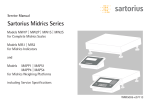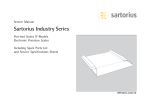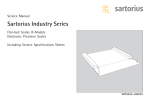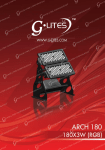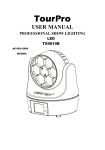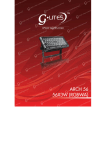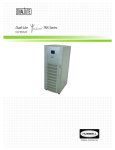Download Service Manual
Transcript
Sartorius Miras Scale Service Manual SARTORIUS Miras Scale Service Manual Sartorius Miras Series Models IW2P1/IW2P4 For Complete Miras Scales Model IIP2 For Miras Indicator And Models IAPP1 | IAPP4 For Miras Weighing Platforms Including Service Specifications VERSION 1.0 2007.5 1 Content Content ..................................................................................................................................................... 2 Overview ................................................................................................................................................... 3 General Information..................................................................................................................... 3 Service Concept..................................................................................................................... 3 Information............................................................................................................................. 3 Description of the Equipment............................................................................................................ 4 General View of the Miras scales.............................................................................................. 4 Indicator........................................................................................................................................... 5 The Key Function Definitions..................................................................................................... 5 Repairing the Miras Indicator ............................................................................................................ 7 Indicator........................................................................................................................................... 7 Replacing the Front Panel .......................................................................................................... 7 Battery Powered Operation........................................................................................................ 8 Blank Display................................................................................................................................... 8 Replacing the Power Cable......................................................................................................... 9 Replacing the Power PCB............................................................................................................ 9 Replacing the Main PCB............................................................................................................10 Adjusting the Weighing Platform...................................................................................................11 Junction Box .................................................................................................................................11 Pin Assignments in the Junction Box ...........................................................................12 Procedure for Off-center Load Adjustment........................................................................13 Adjusting the Off-center Load................................................................................................13 Determining the Resistance for Adjustment of the Off-center Load .........................14 Determining Resistance Values.......................................................................................14 Sample Calculation Based on Diagram 1 ....................................................................14 Selecting the Adjustment Resistor ................................................................................15 Adjusting the Linearity ..............................................................................................................16 Setting the Overload Stops ......................................................................................................17 Repairing the Weighing Platforms .................................................................................................17 Replacing the Connecting Cable ............................................................................................17 Replacing Load Cells...................................................................................................................18 Replacing the Load Cell Foot ...................................................................................................19 Error Codes.............................................................................................................................................20 2 SARTORIUS Miras Scale Overview General Information Service Concept A prerequisite for performing maintenance and repair work on Sartorius Miras scales requires considerable experience with both indicators and weighing platforms. In case of defects, repairs are performed on site. Generally, the equipment is not replaced. ¾ Do not connect or disconnect cables to or from the equipment; always disconnect the power cable from the wall socket (mains supply) first! Information To ensure safety, an isolating transformer must be installed between the indicator and the power supply before performing work that entails opening the Miras indicator housing. On complete Miras scales, check and adjust as necessary: ¾ Repeatability (standard deviation) ¾ Off-center load ¾ Span ¾ Linearity (The procedure is the same as for all scale and weighing platform models.) Overview of the Models The hardware configuration consists of a Miras indicator and Sartorius weighing platform(s), or a Miras indicator and weighing platform(s) (strain-gauge load cells) from another manufacturer. Mechanical and electrical service or repair work on the complete Miras scale requires considerable experience, and for this reason should be performed only by Sartorius technicians trained at the factory. Any attempt to perform repair work can result in damage to the equipment. Auxiliary Service Tools and Equipment In addition to standard tools, you will need the following special tools to work on the complete Miras scale: 3 Qty. Designation 1 Socket wrench, double hexagon, 10-32 mm, square driver (1/2“) 1 Torque wrench, 10-120 Nm 14x18, stainless steel 1 Set of open-ended wrenches with sockets 1 Set of screwdrivers (slotted) 1 Set of Allen wrenches Description of the Equipment The complete Miras scales from Sartorius are primarily used in industry. Because there are a number of hardware configurations to choose from, Miras models are constructed according to customer requirements. General View of the Miras scales The complete Miras scale consists of: ¾ A choice of weighing platforms with capacities from 3 kg to 3000 kg (in steel) and indicators 1. 2. 3. 4. 5. 6. 7. 8. 9. 10. 11. 12. 4 Name Plate Housing Power Cable Indicator Holder Indicator Pole Pole Support foot Bubble Leveling feet Stainless Cover/Pan Power Plug Cable gland cover for Load Cell SARTORIUS Miras Scale Indicator The Miras indicators consist of: ¾ Front panel with keypad and digital display Main PCB Power PCB Battery Powered ¾ Miras indicators are equipped with either cable glands Note: Additional electronic subassemblies are option The Key Function Definitions 1) On/Off ”on/off” function will depend on different power supply condition. Needs setup menu for Back light control and for Auto power off. When System is connected to mains and the « On/Off » switch turns the system on or 5 off. ¾ Off-Mode: Scale is in standby mode but there is no display visible (no backlight, no symbols, no display) ¾ On-Mode: Scale is in operation and the display shows the function, which is in use. In this mode, “power auto off” function is invalid. When system runs on batteries and the « On/Off » switch turns the system on or off. ¾ Off-Mode: Scale is totally off. ¾ On-Mode: Scale is in operation and the display shows the function, which is in use. Back light works based on setup menu In this mode, “power auto off” function is valid. After 5, 10, 15 minutes system goes off when not in use according to the setup menu. 2) Zero / Arrow-Left (ZERO/LEFT) ¾ Weighing Mode: Set scale zero ¾ Parameter Mode: Shift set position of digit to the Left 3) Tare / Arrow-Right (TARE/RIGHT) ¾ Weighing Mode: Set scale Tare ¾ Parameter Mode: Shift set position of digit to the Right 4) Gross-Net/Arrow-Down (G/N/DOWN) ¾ Weighing Mode: Toggle Weight Unit Gross & Net ¾ Counting Mode: Toggle Weight Unit Gross, Net & Pcs ¾ Function Mode: To scroll Down menu selection ¾ Parameter Mode: Decrement digit 5) Function / Arrow-Up (Fn/UP) ¾ Weighing Mode: Switch the scale from Normal Weight mode to Application Setup mode ¾ Function Mode: To scroll Up menu selection ¾ Parameter Mode: Increment digit 6) Print/Enter (PRINT/ENTER) ¾ Weighing Mode: Print key ¾ Function mode: To scroll Level up in menu Mode/Confirm menu selected.、 6 SARTORIUS Miras Scale Repairing the Miras Indicator Indicator Important: ¾ To open the Miras indicator, remove the six nuts as shown in the illustration on the left Note: After completing maintenance or repair work, check the seal between the front panel and the housing body for damage and replace if necessary. If the Miras indicator in question has an IP65-like protection rating, a special test procedure is used to check the IP65-like protection after the housing has been closed. Replacing the Front Panel ¾ In the case of a defective key, keypad overlay, or display, the entire front panel must be replaced. ¾ If the indicator housing seal cord is defective, it must be replaced. When installing a new seal code .make sure it rests entirely within the housing and is not caught between the upper and lower housing parts when you close the indicator. Seal code 7 Battery Powered Operation If the user intended to use battery operation ¾ Open the battery cover at the back of the Indicator. ¾ Insert 6 pieces 1.5 V D size dry cell into the battery compartment. ¾ In case battery sign is appeared on the display, It means the battery power is weak. You are required to replace new batteries. Blank Display If the display is blank (dark), disconnect the equipment from mains, open the housing and disconnect all cables and wires from the subassemblies. Then connect the equipment to power again through an isolating transformer and connect all subassemblies again, measuring the supply voltage in each case. ¾ The voltage at the power supply output (connector A; see page 8) is 12V ± 0.3 V direct current. 8 SARTORIUS Miras Scale Replacing the Power Cable ¾ Disconnect the cable from the power source. ¾ Open the housing. ¾ Replace the cable Note: After replacing the power cable, use a torque wrench to tighten the cable gland to 3 Nm. Replacing the Power PCB ¾ Disconnect the cable from the power source. ¾ Pry the shield cap from the power PCB. To do this, remove the two screws as shown in the illustration on the left. ¾ Remove the protective cap and disconnect the three wires (blue/brown/green). A ¾ Unplug connector A, remove the 3 screws and replace the power supply. After replacing the PCB, make sure to return the shield cap to its original position. 9 Replacing the Main PCB ¾ Before replacing the main PCB, try to read out the data from the main PCB controller using the service software; if this is successful, you can load the adjustment data in the controller of the new main PCB once it is installed. In many cases, this precludes the need to adjust the weighing system. Quick-test of the A/D Converter Pin Assignment Chart Quick-test of the A/D Converter Pin Assignment in the indicator No. Signal designation Meaning 1. +Excitation Bridge supply voltage positive 2. +Sense Sense positive 3. +Output Measuring Voltage positive 4. -Output Measuring Voltage negative 5. -Sense Sense negative 6. -Excitation Bridge supply voltage negative Replacing the Main PCB ¾ Switch off the indicator. key while switching the indicator ¾ Press and hold the on again. All segments are displayed. ¾ In case of defect, replace the main PCB. ¾ After replacing the main PCB, use the FDT3.7.exe program to load the software. Following installation and commissioning of the new main PCB, the display backlighting should blink on and off. POWER_CON 10 DRY_CELL SARTORIUS Miras Scale Adjusting the Weighing Platform Version with the junction box (5) Part no. 7-36105-400-00 The illustration on the left shows LL frame 1000x1000 1. Load cell 1 2. Load cell 2 3. Load cell 3 4. Load cell 4 5. Junction box Junction Box 1. Cable to load cell 1 2. Cable to load cell 2 3. Cable to load cell 3 4. Cable to load cell 4 5. Connecting cable for A/D Converter / indicator 11 Pin Assignments in the Junction Box The Terminal comprises Load cell-1, Load cell-2, Load cell-3, Load cell-4 and Indicator. The Loadcell-1, Loadcell-2, Loadcell-3, Loadcell-4 are connect to the four cell, and the indicator is connect to the A/D converter and the indicator. Connections in the Junction Box for the Load Cells 1-4 Designation 4 wires type 6 wires type S+ +output Green Green S- -output White White Se- -sense P- -supply Se+ +sense P+ +supply Red Red Sc shield colorless colorless Blue black black Brown/ Yellow Connections in the Junction Box for the A/D Converter Designation 12 4 wires type 6 wires type S+ +output Green Green S- -output White White M- -sense V- -supply M+ +sense V+ +supply Blue black black Brown/ Yellow Red Red SARTORIUS Miras Scale Note: The color coding of the connecting cable (A/D converter / indicator to junction box) might be different when connecting a non-Sartorius platform to the Miras indicator. Procedure for Off-center Load Adjustment Proceed as follows to adjust the off-center load using the junction box: ¾ Stand the weighing platform (with 4 load cells) on its side and secure it in this position. ¾ Remove the four screws (S) from the junction box. ¾ Pull approximately 20 to 30 cm of the load cell cables out of the platform (see arrow). ¾ Return the weighing platform to the horizontal and position it next to the junction box. ¾ The junction box is now accessible for adjustment of the resistors. ¾ At the conclusion of off-center load adjustment, follow the instructions above in reverse order to reassemble the weighing platform. Important: Make sure to push the cables back into the weighing platform. Adjusting the Off-center Load If the weighing platform has only 1 load cell, the off-center load is not adjusted in case of error. The load cell must be replaced. The off-center load is adjusted only in weighing platforms that have 4 load cells. Mechanical asymmetries can result in off-center loading errors that exceed permissible tolerance limits. Such errors must be compensated by soldering resistors to the PCB in the junction box. The 4 solder bridges for the resistors are short-circuited at the factory (see the illustration on the left; note the 4 solder bridges and the sequence of the load cells). 13 Note: The off-center load is adjusted only in weighing platforms that have 4 load cells.Mechanical asymmetries can result in off-center loading errors that exceed permissible tolerance limits. Such errors must be compensated by soldering resistors to the PCB in the junction box. To minimize the off-center loading error, use the load cell with the lowest readout value as a reference. Then adjust the other load cells to this value by adding resistors. Determining the Resistance for Adjustment of the Off-center Load Determining Resistance Values ¾ Place the test weight on each load cell in turn and write down each displayed value. ¾ Using the lowest displayed value as the basis, calculated the resistance values for the other load cells in accordance with the following equation: Equation: R = R(0) x G(D) / G(T) R = required resistance (in ohms) R(0) = Initial resistance in the load cell being adjusted (in ohms), (if not specified in the specification sheet) measured between Signal + (OUT_POS, positive measuring voltage) and Signal - (OUT_NEG, negative measuring voltage). G(D) = Difference between lowest off-center loading error (from reference load cell) and the off-center load value displayed for the weigh cell (in kg). G(T) = Test weight applied (in kg) ¾ Solder the required resistor into the bridge of the load cell being adjusted. ¾ Then perform calibration/adjustment again. Sample Calculation Based on Diagram 1 Initial resistance in the load cell: 350 ohms. ¾ Test weight: 500 kg ¾ Readout for reference load cell = 498 kg (load cell with the lowest readout value). ¾ Readout for load cell being adjusted = 501.1 kg ¾ G(D) = 3.1 kg R =[ R(0) x G(D)] / G(T) R = (350 ohms x 3.1 kg)/ 500 kg R = 2.17 ohms In this example, note that the test weight (500 kg) is also distributed over the other load cells, which means that the weight on the load cell being tested is 14 SARTORIUS Miras Scale somewhat lighter. To compensate for this effect, always use the next higher resistor value. R = 2.17 ohms ((resistor to be installed (see page 42)). Selecting the Adjustment Resistor Adjusting Off-center Load with 350 Ohms Initial Resistance Adjustment resistor (in ohm) Test weight 100kg Test weight 200kg Test weight 500kg Test weight 1000kg Off-center(in kg) 0 0.00-0.05 0.0-0.1 0.0-0.1 0.0-0.3 0.28 0.05-0.07 0.1-0.1 0.1-0.4 0.3-0.7 0.35 0.08-0.11 0.1-0.2 0.4-0.5 0.8-1.1 0.56 0.12-0.15 0.2-0.3 0.6-0.8 1.2-1.5 0.7 0.16-0.19 0.3-0.4 0.8-1.0 1.6-1.9 0.91 0.20-0.26 0.4-0.5 1.0-1.3 2.0-2.6 1.05 0.27-0.29 0.5-0.6 1.3-1.5 2.7-2.9 1.12 0.30-0.32 0.6-0.7 1.5-1.6 3.0-3.2 1.33 0.33-0.38 0.7-0.8 1.6-1.9 3.3-3.8 1.61 0.39-0.46 0.8-.9 1.9-2.3 3.9-4.6 1.89 0.47-0.55 0.9-1.1 2.3-2.7 4.7-5.5 2.17 0.56-0.66 1.1-1.3 2.8-3.1 5.6-6.6 15 Adjusting the Linearity Proceed as follows to adjusting the Linearity Calibration Mode Menu: Calibrate/Linearity the Scale 16 SARTORIUS Miras Scale Note: the calibration weight is the entire weighing, And the metrical Linearization weight be required less than the calibration weight. Setting the Overload Stops 1. Weighing Platforms with One Load Cell: Steel Platform nominal capacity in kg Test weight for middle stops in kg Test weight for corner stops in kg 3 3 + 20% 3 + 10% 6 6 + 20% 6 + 10% 15 15 + 20% 15 + 10% 30 30 + 20% 30 + 10% 60 60 + 20% 60 + 10% 150 150 + 20% 150 + 10% 300 300 + 20% 300 + 10% 2. Weighing Platforms with Four Load Cells: Steel Platform nominal capacity in kg Test weight for middle stops in kg Test weight for capacity in corner stop in kg Nominal load cell measurement path mm (in kg) 150 900 600 0.5 (MP58T-91kg) 300 900 600 0.5 (MP58T-91kg) 600 3500 1500 0.5 (MP58T-91kg) 1500 3500 1500 0.5 (MP58T-91kg) 3000 3500 1500 0.5 (MP58T-91kg) Repairing the Weighing Platforms Replacing the Connecting Cable If the connecting cable (from junction box to Miras indicator) needs to be replaced on a weighing platform with four load cells, or if the load cell needs to be replaced on a platform with only one load cell , open the Miras indicator and disconnect the cable from the terminal strip of the A/D converter. Unscrew the cable gland; the cable or load cell can now be replaced. Remove the isolation and connect the new cable: 17 ¾ Expose approx. 6 cm (2.4 in.) of the wires (3) in the cable. ¾ Remove the isolation from approx. 1 cm (0.5 in.) of the wires and affix ferrules to the wire ends. ¾ Thread the cable through the cable gland. ¾ The shielding (1) must have contact with the clamps (2). Connection to ground via the shield. ¾ After replacing the cable or load cell, use a torque wrench to tighten the cable gland to 5 Nm. Note: On stainless steel models, the IP67 protection must be checked after closing the junction box. Replacing Load Cells If an off-center load error is detected (platforms with one load cell), or if the output signal from the load cell is too high or too low, replace the load cell. Because the mechanical construction of the platforms is basically uncomplicated, no detailed description of the disassembly procedure is included here. Important: To replace a load cell in a platform with four load cells, use two eye bolts (010238) in two corners and then lift the weighing platform. Remove the plastic caps from the bore holes before inserting the eye bolts. The eye bolts can be ordered under spare part number 010238. ¾ When reassembling the weighing platform, make sure to replace any plates that were under the platform frame. ¾ Tighten the load cells with the required torque. 18 SARTORIUS Miras Scale Torque Values ¾ Load cell Type No.: Torque value N.m Load cell Type No.: Torque value N.m DC-C3-8kg 10 FE-C3-50kg 25 DC-C3-15kg 10 FE-C3-100kg 25 DC-C3-30kg 10 FE-C3-250kg 25 DC-C3-50kg 10 FE-C3-500kg 25 ED-C3-8kg 14 GF-C3-250kg 35 ED-C3-15kg 14 GF-C3-500kg 35 ED-C3-30kg 14 GF-C3-635kg 35 ED-C3-50kg 14 LL-C3-500kg 100 ED-C3-100kg 14 LL-C3-1000kg 100 LL-C3-1500kg 100 After replacing load cells, you need to check the overload stops and adjust them if necessary (see page 15-16). Replacing the Load Cell Foot ¾ To replace a load cell foot, use a screwdriver to pry the retainer spring free and push it out, or loosen the nut and remove the screw (see arrow in the lower illustration on the left). Load cell color code Terminal assignment For Load Cell 4 wires type 6 wires type 1 Red Red 2 3 4 Blue Green Green White White 5 6 Brown/Yellow black Black 19 Error Codes Error codes are shown on the main display. Err codes are shown continuously; Inf. messages are shown for 2 seconds, after which the program returns automatically to the weighing mode. Problem Cause Solution Nothing appears or some symbols exist desultorily on the display ¾ ¾ Check the power supply Plug in the AC adapter ¾ No power available The AC adapter is not plugged in Battery is drained ¾ Replace battery; chargeable battery or using external charger ¾ LCD cable is loose ¾ Plug in the cable again or ¾ ¾ contact with Miras customer service ¾ The load exceeds the balance/scale capacity ¾ Unload the balance/scale ¾ Weighing pan is not in place Something is touching the weighing pan ¾ Place the weighing pan on the pan Move the object that is touching the weighing pan Display overflow: Value cannot be shown on the display ¾ Reduce the load on the Calibration parameter not met; ¾ ¾ ¾ ¾ e.g.: --balance/scale not zeroed --balance/scale is loaded 20 ¾ balance/scale ¾ ¾ Calibrate only when zero is displayed Press(zero) to tare the balance/scale Unload the balance /scale ¾ Weight is too high or there is no sample on the balance/scale with application in use ¾ Increase the weight on thebalance/scale ¾ Data interface for printing is blocked ¾ Contact the Miras customer service center ¾ APP board can’t get data from AD board ¾ Contact the Miras customer service center ¾ EEPROM defective ¾ Contact the Miras customer service center SARTORIUS Miras Scale ¾ Function not allowed in scales verified for use in legal metrology ¾ Contact the Miras customer service center ¾ There is no such SBI command for Miras ¾ Contact the Miras customer service center ¾ Zero is not possible ¾ Remove some objects from scale ¾ Tare is not possible when the gross weight is a minus value ¾ Zero the balance/scale ¾ No platform is connected ¾ Connect a platform or sensor Max. weighing capacity is less than indicated under “calibrate” ¾ The balance/scale is switched on without the weighing pan in place ¾ Place the weighing pan on the balance/scale and press “ON/OFF” The weight readout is obviously wrong ¾ The balance/scale was not calibrated/adjusted before weighing Balance/scale not zeroed ¾ Calibrate/adjusted the balance/scale Zero the balance/scale ¾ ¾ 21
























